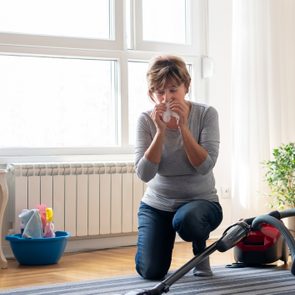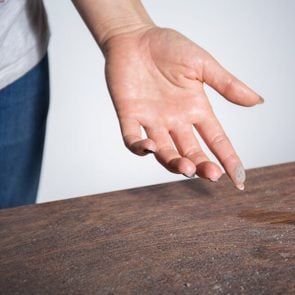Here’s What You Need to Know About Dust Mite Allergies
Updated: Jul. 09, 2021
We can't see dust mites, but they're all around us—and up to 20 million Americans are allergic to them. Here's what you should know about these tiny pests, including how they can cause allergies.
What are dust mites?
They’re creepy and they’re crawly, and if that wasn’t enough to make you cringe, dust mites often make themselves at home in your mattresses and pillows.
If you’re unlucky enough to be allergic to these critters, you may sniffle, sneeze or wheeze 365 days a year, as a dust mite allergy is perennial.
Dust mites are microscopic white creatures with eight legs. Like spiders, they are in a family of invertebrates called arachnids, part of a broader group known as arthropods.
At roughly one-quarter to one-third of a millimeter in length, you can’t see dust mites unless you are using a microscope.
“They look like some alien creature,” says Russell Leftwich, MD, an allergist in Nashville and spokesperson for the American Academy of Allergy, Asthma, and Immunology (AAAAI).
There are many species of dust mites, but the two most common in the United States are the North American house dust mite, Dermatophagoides farinae, and the European house dust mite, D. pteronyssinus, according to entomologists at the University of Kentucky.
Dust mites are not parasites and do not bite. Instead, they feast on the tiny flakes of dead skin we shed each day. And that’s more than enough to feed an army. The average adult human sheds up to 1.5 grams of skin a day, which can feed one million dust mites.
Where do they live?
Flakes of dead skin are nestled in your furniture, carpets, bedding, curtains—even in your stuffed animals. That’s where you’ll find dust mites.
“They live where humans live and shed dead skin cells,” Dr. Leftwich explains. “They don’t live on humans; they live in our pillows, mattresses, upholstered furniture, carpets, movie theater seats, and airplane seats.”
The life cycle of a dust mite comprises five stages: egg, larva, protonymph, tritonymph, and adult. The transition from egg to adult takes one month if conditions are optimal. Adult dust mites can live up to two months, and a female can lay anywhere from 50 to 100 eggs.
Dust mites need a warm and humid environment to survive.
“Dust mites thrive in temperatures of 68 to 77 degrees Fahrenheit, and they also like humidity levels of 70 to 80 percent,” Dr. Leftwich says.
Dust mites don’t drink water, but they do need it to survive. The only way they can get water is from humidity in your home.
“They need humidity levels above 50 percent to thrive, so lowering humidity helps,” he says. “There are fewer dust mites in desert climates, where humidity is always low.”
About four out of five homes in the United States have detectable levels of dust mite allergen in at least one bed, according to the American Lung Association, and an infested mattress can contain millions of dust mites.
Of course, not everyone reacts to dust mites, but for the 20 million Americans who do, symptoms such as sneezing, sniffling, and wheezing can be relentless. There is no high season for dust mites—these pesky buggers are around all year long, Dr. Leftwich says.

Dust mite allergy: causes and symptoms
If you are allergic and inhale microscopic fecal matter and dead body parts of dust mites, your body’s immune system is rattled and produces antibodies against the allergens, kick-starting the process that causes your symptoms.
As part of this process, your body releases histamines that cause the telltale sniffling, sneezing, itchy eyes, and other symptoms of dust mite allergy.
“The protein that an individual with dust mite allergy is allergic to is in [the mites’] bodies but also in their fecal pellets, so even when they are dead, there is still something there to trigger allergies,” Dr. Leftwich explains.
When you tidy up, make your bed, or play a board game on the carpet with your kids, these allergens may become airborne and inhaled, causing your symptoms, he says.
Dust mite allergy symptoms include:
- Sneezing
- Runny nose
- Itchy eyes
- Stuffed-up nose
- Itchiness in your nose, mouth, or throat
- Itchy skin or eczema
- Postnasal drip
- Cough
- Asthma attacks, if you have asthma
Diagnosing dust mite allergies
Skin and/or blood testing can help your allergist determine if dust mites are causing your symptoms.
These results, along with a history of when and where you experience symptoms and a physical exam, provide clues to help your doctor determine the source of your allergies.
With skin testing, a drop of the potential culprit or culprits is placed on your skin. The doctor then scratches your skin to get the allergen into your body.
From there, you’ll wait to see if you develop redness, swelling, or itching at the site. These are signs of an allergic reaction. You will be observed closely during testing.
Blood tests measure the number of immunoglobulin E (IgE) antibodies in your blood. If you are allergic to dust mites, your immune system overreacts to it by producing these antibodies. An abundance of IgE points to an allergy, though there are a lot of false positives with this method.
Reducing dust mite exposure at home
It’s nearly impossible to completely get rid of dust mites, but there are many things you can do to reduce exposure. It may cost a bit of time and money, but they’re well spent if they can help you avoid year-round symptoms.
Protect your pillows and mattress
For starters, consider dust-mite-proof covers on your pillows and mattresses, Dr. Leftwich says. These covers are made with a material that has tiny pores that don’t let dust mites and their waste products in.
Finely woven fabrics keep dust mites out, according to a 2018 study in The Journal of Allergy and Clinical Immunology: In Practice.
Wash your bedding
It’s also important to wash your sheets in hot water and run them through the hot dryer cycle once a week to kill dust mites and get rid of residual dust-mite particulate matter.
You can do the same for machine-washable blankets and other textiles.
Go with hardwood
Replace wall-to-wall carpeting with hardwood floors and area rugs, says Neeta Ogden, MD, an allergist and immunologist in Edison, New Jersey, and a spokesperson for the American College of Allergy, Asthma, and Immunology (ACAAI).
You can just toss area rugs in the washing machine to get rid of unwanted dust mites.
Hardwood floors are also less likely to harbor dust mites, as they can be cleaned often and easily, she says.
Skip fabric when you can
Avoid fabric drapes and headboards, which can offer respite to hungry dust mites, Dr. Ogden says.
If someone in your home is allergic to dust mites, choose blinds and furniture that you can easily wipe down, she suggests.
Upgrade your vacuum
Vacuum regularly using a vacuum with a high-efficiency particulate air (HEPA) filter to get dust mites up and out. If you are not using a HEPA filter, your vacuum could spit dust mites back into the air around you.
HEPA filters, on the other hand, can trap dust mites, saving you from symptom flare-ups. These are the best HEPA filter vacuums if you have allergies.
Even if you’re using one, consider asking another family member to do the vacuuming if you’re allergic to dust mites. If no one steps up, wear a mask when dusting and vacuuming.
Use an air purifier
A HEPA filter air purifier that you can take from room to room can also help clear the air, adds Karin Pacheco, MD, MSPH, an allergist and associate professor in the division of environmental and occupational health sciences at National Jewish Health in Denver.
These are eight of the best air purifiers for allergies.
Treating dust mite allergies
Allergy shots, or immunotherapy, can help your body gradually get accustomed to an allergen like dust mites so it won’t launch an attack when you encounter the allergen again in the future.
“A yearlong course of immunotherapy can be effective,” Dr. Leftwich says.
Targeted symptom relief is also a big help, he says. If you have itchy, watery eyes, eye drops can bring relief.
Over-the-counter or prescription antihistamines or nasal sprays can reduce sneezing, congestion, and runny noses. If you have asthma, steroid inhalers and other asthma medications can help keep attacks at bay.
If you think you are allergic to dust mites, schedule a visit with an allergist to confirm what is causing your symptoms. Your allergist will work with you to develop a plan to reduce your exposure to dust mites and help treat your symptoms.



















